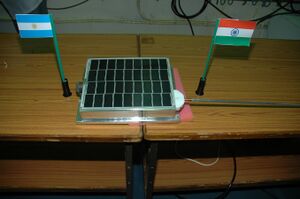Engineering:Pehuensat-1
 | |
| Mission type | Amateur Radio |
|---|---|
| Operator | Universidad Nacional del Comahue , Asociación Argentina de Tecnología Espacial, AMSAT Argentina |
| COSPAR ID | 2007-001D |
| Website | https://investigadores.uncoma.edu.ar/AplicacionesEspaciales/pehuen.htm |
| Spacecraft properties | |
| Launch mass | 6 kg |
| Start of mission | |
| Launch date | January 10, 10:00 UTC |
| Launch site | Satish Dhawan PSLV C7 |
| End of mission | |
| Decay date | 16 January 2023 |
| Orbital parameters | |
| Regime | LEO |
| Periapsis altitude | 596 km |
| Apoapsis altitude | 615 km |
| Period | 96.7 min |
Pehuensat-1 is a satellite built entirely in Argentina with educational objectives. It was launched on January 10, 2007 aboard a rocket from the Satish Dhawan Space Center on the east coast of India . The assembly took five years and was carried out by teachers and students of the National University of Comahue.[1][2]
It was named Pehuensat-1 in reference to the pehuén, an ancient and native tree of the Andean Patagonian forests identified with the provinces in which the university has its academic headquarters.[3]
Details
It was built by 17 teachers and 44 students from the Faculty of Engineering of the University of Comahue (Neuquén). In October 2006, the satellite was taken to the launch center in Shriharikota (India), by the Argentine space researcher Pablo de León, who became known months ago when he presented a prototype of a space suit designed for trips to Mars.[4]
It was launched at 9:23 a.m. Indian time (1:53 a.m. Argentine time) on the Indian Polar Satellite Launch Vehicle PSLV C7 rocket.[5]
After 20 minutes of travel, Pehuensat-1 reached its orbit, where it will remain -according to the technicians- for "several years".[6][7]
The satellite weighs 6 kilograms, travels its orb LM Neuquen at an altitude of about 640 kilometers and orbits the Earth at a speed of 27,000 kilometres per hour (17,000 mph) (about 7.5 km/s (4.7 mi/s). It has a space-type aluminum case structure and solar panels on one of the faces. The electronics are made up of a transmitter, a computer and two battery packs that are recharged with solar energy. In addition, an antenna in charge of transmitting the satellite parameters to the ground.[8]
Pehuensat-1 can withstand temperatures in space of −120 °C (−184 °F) (every time it passes through the Earth's shadow) and up to 100 °C (212 °F) (facing the Sun). It will be useful to high schools and universities around the world, because it transmits its data in multiple languages to amateur radio receivers. When flying over an area, The satellite only needs to tune to the 145.825 MHz frequency in the 2-meter band in FM mode. The Pehuensat-1 satellite transmits its data in Spanish, English and Hindi.[9]
References
- ↑ "Lanzan un satélite construido en la Argentina". conicet.gov.ar. 2007. http://www.conicet.gov.ar/NOTICIAS/ACTUALIDAD/2007/enero/010.php.
- ↑ "PehuenSat 1 (PO 63, PehuenSat-OSCAR 63)" (in en). https://space.skyrocket.de/doc_sdat/pehuensat.htm.
- ↑ UNIVERSIDAD NACIONAL DEL COMAHUE , AMSAT Argentina. "PehuenSat" (in Spanish). https://investigadores.uncoma.edu.ar/AplicacionesEspaciales/pehuen.htm.
- ↑ "Lanzaron un satélite construido en la UNCO". 2007. https://www.conicet.gov.ar/.
- ↑ Indian Space Research Organization (2022). "PSLV-C7 / CARTOSAT-2 / SRE-1". https://www.isro.gov.in/mission_PSLV_C7_CARTOSAT_2_SRE_1.html?timeline=timeline.
- ↑ AMSAT Argentina (2007). "PEHUENSAT-1". http://www.amsat.org.ar/pehuens.html.
- ↑ Redacción (2007). "El primer satélite hecho en la UNC, rumbo al espacio" (in Spanish). https://www.rionegro.com.ar/el-primer-satelite-hecho-en-la-unc-rumbo-al-espacio-EVHRN2007123102060/.
- ↑ Asociación Argentina de Tecnología Espacial (2007). "El Pehuensat-1 concluye exitosamente su mision". https://www.aate.org/pehuensat.html.
- ↑ Calducci, Ana Laura (2021). "El primer satélite que habló en español se hizo en Neuquén" (in Spanish). https://www.lmneuquen.com/el-primer-satelite-que-hablo-espanol-se-hizo-neuquen-n763570.
 |

